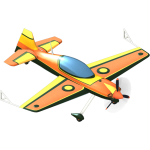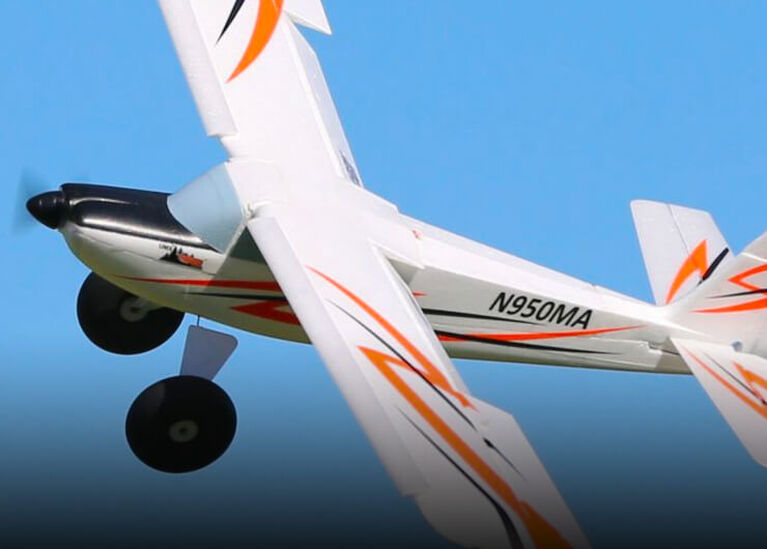Learning to Fly RC Planes – Lesson 5: Your next few flights
Prerequisites: You’ve done your first flight. Hopefully, you still have a plane.
Objectives: Learn some things about aircraft repair, some more flying and simulator exercises.
Repairing your plane
Contents
It didn’t seem appropriate to talk about this before your first flight for obvious reasons. Now that you have done that let’s have a quick chat about repairing your plane.
I are not going to try and give you a full list of techniques or anything like that. Places like rcuniverse.com and rcgroups.com are full of helpful people in forums who you can ask about particular details. I are going to try and give a really quick overview of some of the materials used when to use them etc.
Repairing foam:
If you need to repair foam you have three choices of glue: Epoxy (Araldite is one type), Foam Glue (such as the GWS and Ultrafly foam glues) or Foam-Safe CA (super glue – but must be foam safe).
Foam Safe CA is best for those jobs where you might have a partial crack through a fuse or wing, and want to get glue through the joint by capillary action without having to pull the joint open (thus increasing the size of the break). It does take a while to dry, and in this application may well need some tape to hold it in place while it drys. You can get foam safe kicker these days to make your CA dry very quickly, even on foam.
Foam Glue is best for building your plane. Of the two mentioned above the Ultrafly glue is far superior. Foam glue takes quite a long while to cure, meaning it is not ideal for repairs.
Epoxy works well enough. However, it can be a fraction heavy and is sometimes more flexible than you might like.
Some people also speak highly of hot glue (and the associated hot glue gun) for this kind of stuff. Personally, I don’t like it and don’t think it is strong enough to justify its weight.
Tapes:
This hobby is going to give you a new appreciation for the load bearing potential of sticky tape, packing tape and other tapes such as fiberglass reinforced tape. The tape is one of the model aviator’s secret weapons in the battle against gravity.
Model planes tend to be so light that tape is actually quite a useful, versatile and (comparatively) strong material. It is also reasonably light, and incredibly easy to use.
Some applications for tape include as a protective layer (on leading and trailing edges and elsewhere) as well as an assistant holding foam in place while it drys. It’s also the premier cowling repair method (yep – just tape her up, if you do the job cleanly and put the tape on the inside people won’t even realize that you smashed the cowling into 4 pieces on the last “landing”).
Repairing Balsa
What the heck are you doing flying balsa? Normal CA and other bits of balsa are best for repairs.
More Flying
You had your first flight, and no doubt it was quite a rush. Hopefully, it lasted a little while and ended well.
The good news is it does start to get easier from here.
For your next 4 flights, you want to follow the same flight plane as for your first flight. Take off, get to altitude and then fly either circuits or figure eights at about 3/4 throttle. You want zero, or very light breezes for these flights.
Before you fly again
Few things you need to check before you fly again:
- Were you able to trim your aircraft or was she still out of trim with the tabs pushed fully in one direction? If you couldn’t then you may need to make some mechanical adjustments before she flys again.
- If there are any particular mistakes you made that you can recall, think about how you might have dealt with them differently, and mentally drill yourself.
- Repair any damage to your plane – trying to fly with a damaged plane will probably get you into trouble. The plane doesn’t need to be perfect, but the wings need to be straight and strong, and the control surfaces need to work properly.
Here are some things to work on your next flights once the plane is high and safe:
Thinking Ahead
As well as concentrating on where your plane is, and what it is doing, a very very important skill, which you should start to develop straight away is thinking ahead of your plane. You need to not only know where your plane is and what it is doing, but you should also be thinking 5 seconds ahead of your plane (is it starting to get close to those trees, in 5 seconds is the plane going to be getting too far away etc).
Concentrating too much on the plane, and not enough on where it will be in 5 seconds time is a sure recipe for disaster. This is how model aircraft get stuck in trees. If you are unlucky it may be so high up it can’t readily be retrieved.
There are two ways we think ahead (and you need to do both) – the first is with our eyes, the second is with our mind.
When you use your eyes, first things first, keep your model in your field of vision at all times. As you may have noticed you only see things really clearly in a very small part in the middle of your vision. The rest of your field of vision is very good at detecting motion, but crap at identifying just about anything else. So, to look ahead of the model, keeping the model in your peripheral vision, glance ahead, and then back at the model.
The second part of thinking ahead is using your mind to build a 3D map of the space you are flying in. This starts when you do your initial assessment of the field during your preflight check (trees over there, creek and some power lines that way, the road behind you, a baseball backstop over there – okay), and is continually added to as you glance ahead of your model. Over time, you will build a very good 3d map of your flying field, to the extent that you will look ahead with your eyes at the hazards you know are there to locate them exactly with respect to your model.
Learning your Stall Speed, and how your plane stalls
Once you have your plane high and safe figure out the minimum throttle you need to fly, intentionally stall your plane to figure out how to recover it, etc.
You could also try a bit of gliding. Shut the power off and just let her glide about. Remember, your model is probably trimmed for power, so with no power, she will tend to stall, dive, stall. To stop this, dive her ever so slightly, or introduce just the smallest amount of down trim.
Get your model back on power before it gets too close to the ground. Ten meters altitude should probably be the minimum you let the model glide down to at this stage.
Some aerobatics
If you are feeling comfortable and happy cruising then try pulling a loop. To do this: Full throttle, push the nose down (not too much) for about a second (for a little more speed) and then pull fullback on the elevator. The plane should pull through the loop. If the plane stalls before looping then next time aim for a little more speed (with a deeper dive – needless to say, start at a slightly higher altitude to allow for this). If it is still stalling you may not be able to pull a tighter loop until you have your controls in a more sensitive position.
One thing that might happen on this loop, which will be unlike your simulator experience is that the plane may not emerge from the loop cleanly – it might do a half roll, stall in the hammerhead position and fall onto its back etc. Believe it or not, there are quite a few things that can go wrong with this maneuver, which is why we want plenty of altitudes – enough time to figure out what has gone wrong and figure out how to fix it.
The diagram on the right shows the situation where the plane stalls when it gets perpendicular to the ground and folds over on its back. If you have enough altitude this is simple to recover from – pull up. If you don’t have enough altitude you crash – simple as that.
I know I keep on harping on about altitude but it is frustrating to watch people get into trouble not because they can’t fly, or couldn’t have recovered the aircraft, but because they just didn’t give themselves enough altitude and time too.
If your plane emerges from the loop in a bank you may find yourself confused about how to recover the plane and restore level flight. The reason you are confused (apart from the fact that stuff is happening faster than you expected) is possible because normally when you give a plane an input to make it bank, your brain knows it gives the opposite input to correct and restore level flight – your brain is relying on memory rather than calculation to figure out the correct input. Understandable – brains are naturally lazy organs and who can blame them. What has happened here is that the brain has no memory of the input given to make the plane bank, and suddenly you are left trying to figure out how to fix this.
A good trainer (with dihedral) will probably self-correct. However, if that is not what you have, you will need to fix this problem yourself. Remember – imagine yourself in the cockpit of the aircraft. If you can’t figure that out then give a small control input and reorient based on that. If you started your maneuver at 20+ meters of altitude you will have time for all of this. If you didn’t you could easily crash.
Landings
You are probably going to be trying to make your landings gentler and gentler now. Just remember that planes often run longer on landing runs than you expect. Give yourself plenty of distance, and remember a slightly rough landing beats a plane stuck in a tree, or crossing a public road at head height.
Enjoy your flying.




